Online Food and Beverage Website Development Report: Methodology
VerifiedAdded on 2020/10/22
|20
|4146
|400
Report
AI Summary
This report outlines the development of a website for an online food and beverage start-up, covering the entire web application lifecycle. It begins with an introduction to information systems and the importance of websites for businesses, particularly in the growing online food sector. The report then delves into the methodology, reviewing the web development lifecycle, including analysis, specification building, design, development, content writing, coding, testing, SEO optimization, and maintenance. The waterfall model is selected and described in detail. The report further explores planning and design, specifically database design and requirement analysis, including case descriptions and explanations of key terms. The assignment emphasizes the importance of database design, data modeling, and normalization to ensure data integrity and efficiency. The report also covers the various stages of website development, from requirement gathering to deployment and maintenance, providing a comprehensive overview of the process.
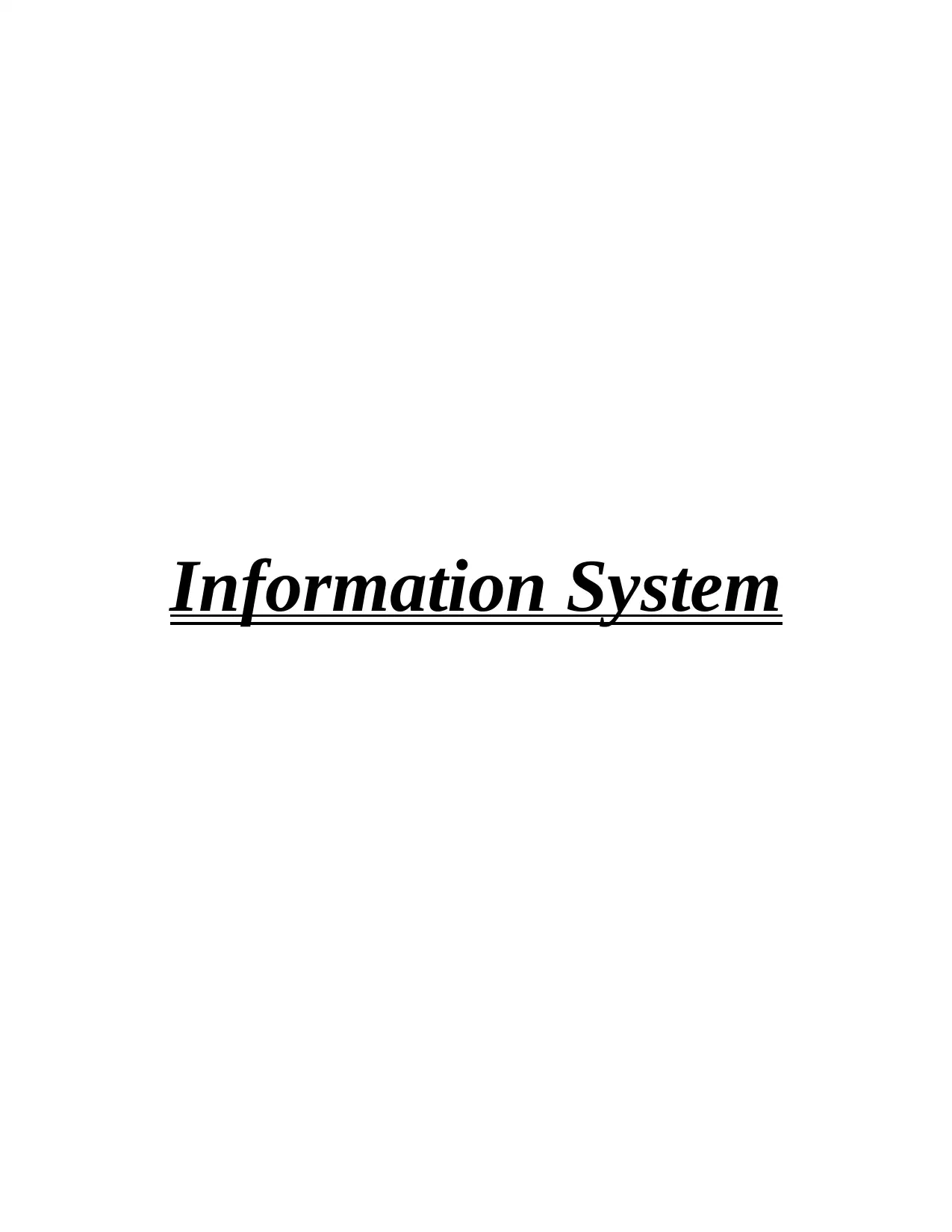
Information System
Paraphrase This Document
Need a fresh take? Get an instant paraphrase of this document with our AI Paraphraser
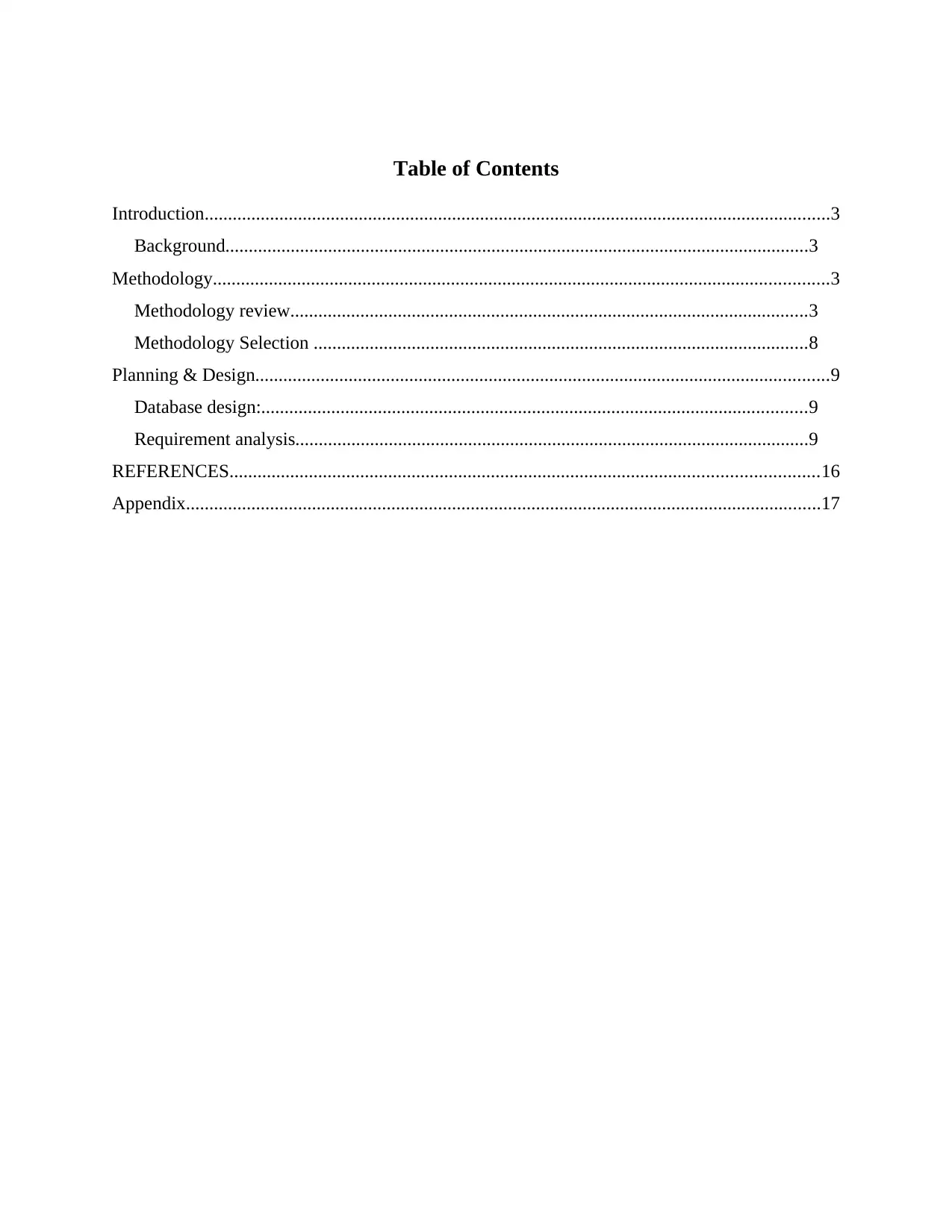
Table of Contents
Introduction......................................................................................................................................3
Background.............................................................................................................................3
Methodology....................................................................................................................................3
Methodology review...............................................................................................................3
Methodology Selection ..........................................................................................................8
Planning & Design...........................................................................................................................9
Database design:.....................................................................................................................9
Requirement analysis..............................................................................................................9
REFERENCES..............................................................................................................................16
Appendix........................................................................................................................................17
Introduction......................................................................................................................................3
Background.............................................................................................................................3
Methodology....................................................................................................................................3
Methodology review...............................................................................................................3
Methodology Selection ..........................................................................................................8
Planning & Design...........................................................................................................................9
Database design:.....................................................................................................................9
Requirement analysis..............................................................................................................9
REFERENCES..............................................................................................................................16
Appendix........................................................................................................................................17
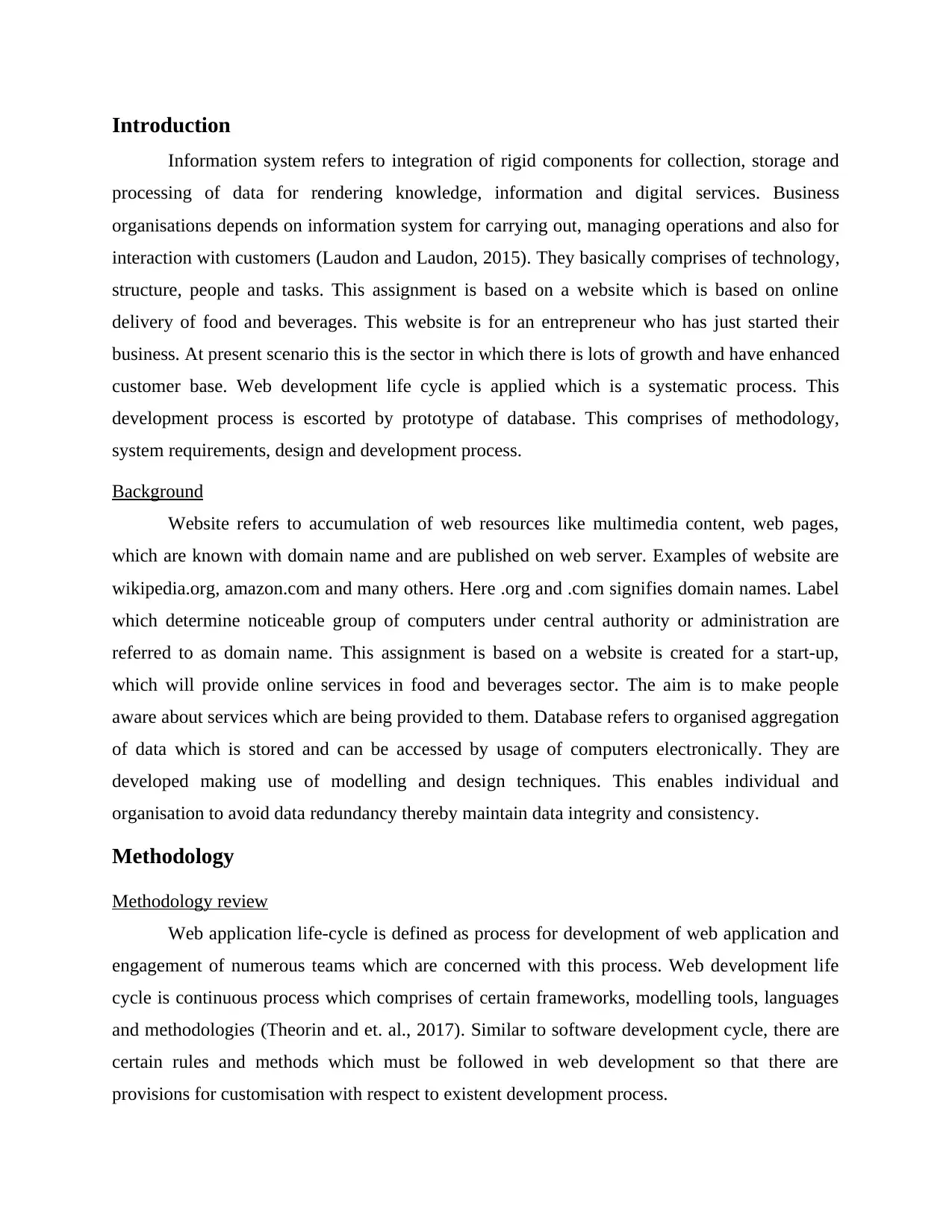
Introduction
Information system refers to integration of rigid components for collection, storage and
processing of data for rendering knowledge, information and digital services. Business
organisations depends on information system for carrying out, managing operations and also for
interaction with customers (Laudon and Laudon, 2015). They basically comprises of technology,
structure, people and tasks. This assignment is based on a website which is based on online
delivery of food and beverages. This website is for an entrepreneur who has just started their
business. At present scenario this is the sector in which there is lots of growth and have enhanced
customer base. Web development life cycle is applied which is a systematic process. This
development process is escorted by prototype of database. This comprises of methodology,
system requirements, design and development process.
Background
Website refers to accumulation of web resources like multimedia content, web pages,
which are known with domain name and are published on web server. Examples of website are
wikipedia.org, amazon.com and many others. Here .org and .com signifies domain names. Label
which determine noticeable group of computers under central authority or administration are
referred to as domain name. This assignment is based on a website is created for a start-up,
which will provide online services in food and beverages sector. The aim is to make people
aware about services which are being provided to them. Database refers to organised aggregation
of data which is stored and can be accessed by usage of computers electronically. They are
developed making use of modelling and design techniques. This enables individual and
organisation to avoid data redundancy thereby maintain data integrity and consistency.
Methodology
Methodology review
Web application life-cycle is defined as process for development of web application and
engagement of numerous teams which are concerned with this process. Web development life
cycle is continuous process which comprises of certain frameworks, modelling tools, languages
and methodologies (Theorin and et. al., 2017). Similar to software development cycle, there are
certain rules and methods which must be followed in web development so that there are
provisions for customisation with respect to existent development process.
Information system refers to integration of rigid components for collection, storage and
processing of data for rendering knowledge, information and digital services. Business
organisations depends on information system for carrying out, managing operations and also for
interaction with customers (Laudon and Laudon, 2015). They basically comprises of technology,
structure, people and tasks. This assignment is based on a website which is based on online
delivery of food and beverages. This website is for an entrepreneur who has just started their
business. At present scenario this is the sector in which there is lots of growth and have enhanced
customer base. Web development life cycle is applied which is a systematic process. This
development process is escorted by prototype of database. This comprises of methodology,
system requirements, design and development process.
Background
Website refers to accumulation of web resources like multimedia content, web pages,
which are known with domain name and are published on web server. Examples of website are
wikipedia.org, amazon.com and many others. Here .org and .com signifies domain names. Label
which determine noticeable group of computers under central authority or administration are
referred to as domain name. This assignment is based on a website is created for a start-up,
which will provide online services in food and beverages sector. The aim is to make people
aware about services which are being provided to them. Database refers to organised aggregation
of data which is stored and can be accessed by usage of computers electronically. They are
developed making use of modelling and design techniques. This enables individual and
organisation to avoid data redundancy thereby maintain data integrity and consistency.
Methodology
Methodology review
Web application life-cycle is defined as process for development of web application and
engagement of numerous teams which are concerned with this process. Web development life
cycle is continuous process which comprises of certain frameworks, modelling tools, languages
and methodologies (Theorin and et. al., 2017). Similar to software development cycle, there are
certain rules and methods which must be followed in web development so that there are
provisions for customisation with respect to existent development process.
⊘ This is a preview!⊘
Do you want full access?
Subscribe today to unlock all pages.

Trusted by 1+ million students worldwide
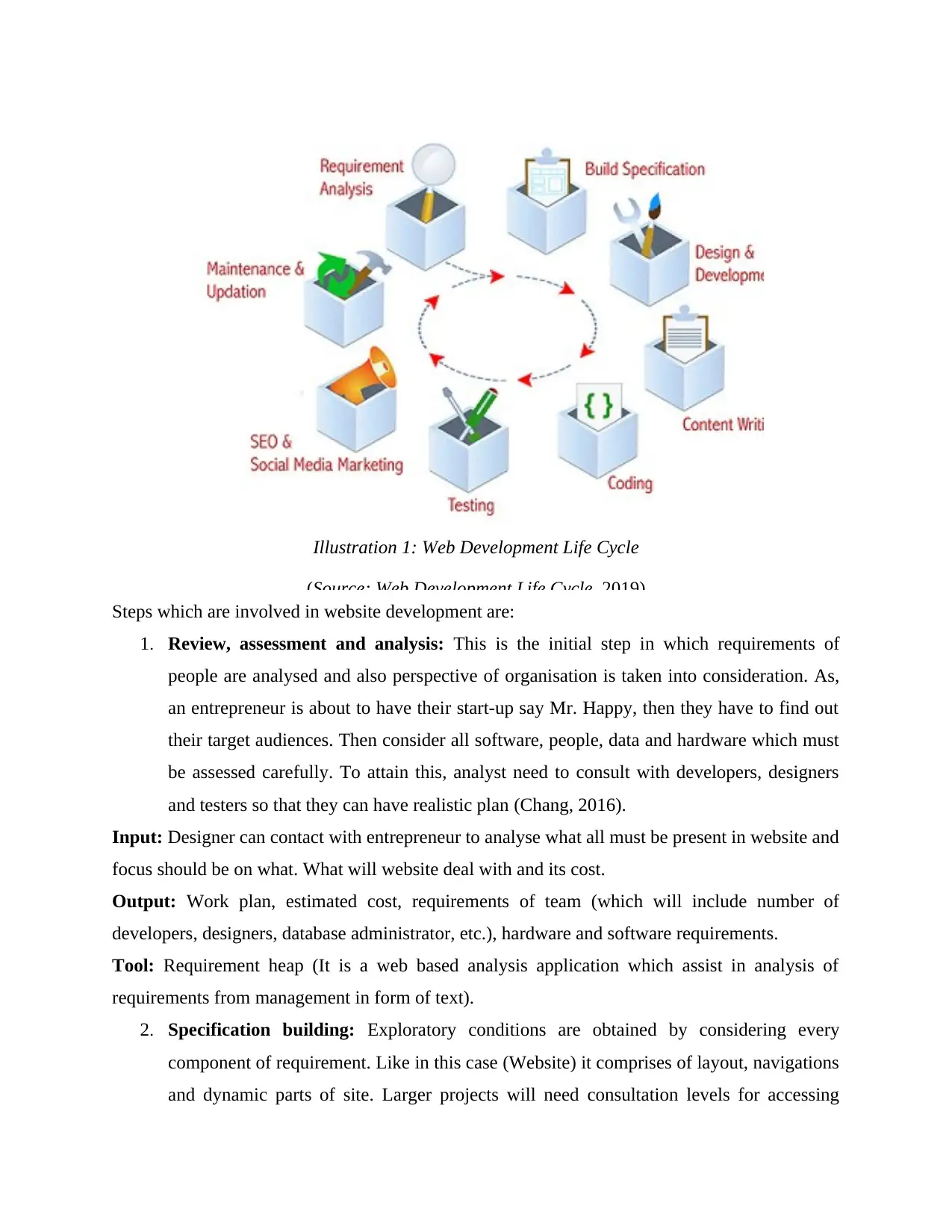
Steps which are involved in website development are:
1. Review, assessment and analysis: This is the initial step in which requirements of
people are analysed and also perspective of organisation is taken into consideration. As,
an entrepreneur is about to have their start-up say Mr. Happy, then they have to find out
their target audiences. Then consider all software, people, data and hardware which must
be assessed carefully. To attain this, analyst need to consult with developers, designers
and testers so that they can have realistic plan (Chang, 2016).
Input: Designer can contact with entrepreneur to analyse what all must be present in website and
focus should be on what. What will website deal with and its cost.
Output: Work plan, estimated cost, requirements of team (which will include number of
developers, designers, database administrator, etc.), hardware and software requirements.
Tool: Requirement heap (It is a web based analysis application which assist in analysis of
requirements from management in form of text).
2. Specification building: Exploratory conditions are obtained by considering every
component of requirement. Like in this case (Website) it comprises of layout, navigations
and dynamic parts of site. Larger projects will need consultation levels for accessing
Illustration 1: Web Development Life Cycle
(Source: Web Development Life Cycle, 2019)
1. Review, assessment and analysis: This is the initial step in which requirements of
people are analysed and also perspective of organisation is taken into consideration. As,
an entrepreneur is about to have their start-up say Mr. Happy, then they have to find out
their target audiences. Then consider all software, people, data and hardware which must
be assessed carefully. To attain this, analyst need to consult with developers, designers
and testers so that they can have realistic plan (Chang, 2016).
Input: Designer can contact with entrepreneur to analyse what all must be present in website and
focus should be on what. What will website deal with and its cost.
Output: Work plan, estimated cost, requirements of team (which will include number of
developers, designers, database administrator, etc.), hardware and software requirements.
Tool: Requirement heap (It is a web based analysis application which assist in analysis of
requirements from management in form of text).
2. Specification building: Exploratory conditions are obtained by considering every
component of requirement. Like in this case (Website) it comprises of layout, navigations
and dynamic parts of site. Larger projects will need consultation levels for accessing
Illustration 1: Web Development Life Cycle
(Source: Web Development Life Cycle, 2019)
Paraphrase This Document
Need a fresh take? Get an instant paraphrase of this document with our AI Paraphraser
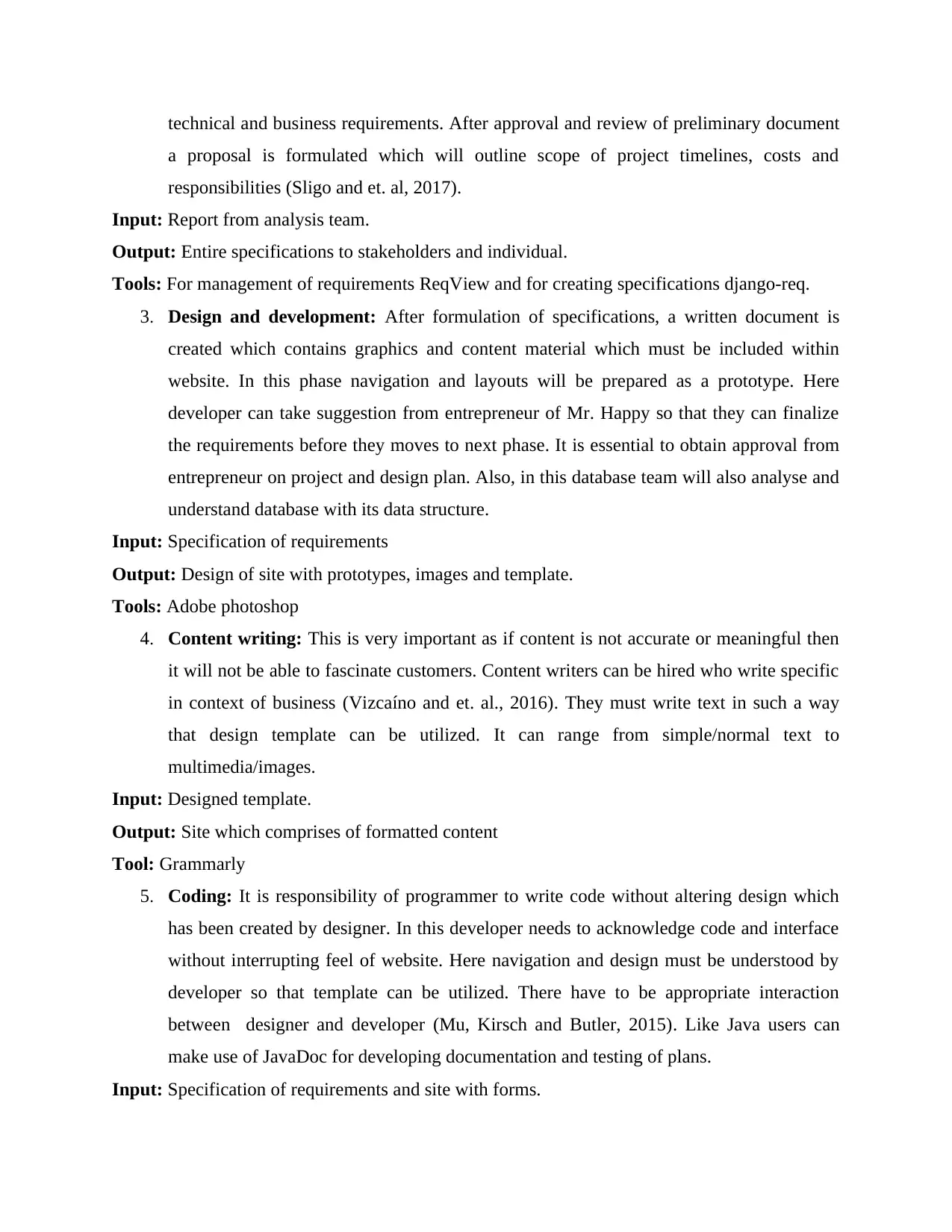
technical and business requirements. After approval and review of preliminary document
a proposal is formulated which will outline scope of project timelines, costs and
responsibilities (Sligo and et. al, 2017).
Input: Report from analysis team.
Output: Entire specifications to stakeholders and individual.
Tools: For management of requirements ReqView and for creating specifications django-req.
3. Design and development: After formulation of specifications, a written document is
created which contains graphics and content material which must be included within
website. In this phase navigation and layouts will be prepared as a prototype. Here
developer can take suggestion from entrepreneur of Mr. Happy so that they can finalize
the requirements before they moves to next phase. It is essential to obtain approval from
entrepreneur on project and design plan. Also, in this database team will also analyse and
understand database with its data structure.
Input: Specification of requirements
Output: Design of site with prototypes, images and template.
Tools: Adobe photoshop
4. Content writing: This is very important as if content is not accurate or meaningful then
it will not be able to fascinate customers. Content writers can be hired who write specific
in context of business (Vizcaíno and et. al., 2016). They must write text in such a way
that design template can be utilized. It can range from simple/normal text to
multimedia/images.
Input: Designed template.
Output: Site which comprises of formatted content
Tool: Grammarly
5. Coding: It is responsibility of programmer to write code without altering design which
has been created by designer. In this developer needs to acknowledge code and interface
without interrupting feel of website. Here navigation and design must be understood by
developer so that template can be utilized. There have to be appropriate interaction
between designer and developer (Mu, Kirsch and Butler, 2015). Like Java users can
make use of JavaDoc for developing documentation and testing of plans.
Input: Specification of requirements and site with forms.
a proposal is formulated which will outline scope of project timelines, costs and
responsibilities (Sligo and et. al, 2017).
Input: Report from analysis team.
Output: Entire specifications to stakeholders and individual.
Tools: For management of requirements ReqView and for creating specifications django-req.
3. Design and development: After formulation of specifications, a written document is
created which contains graphics and content material which must be included within
website. In this phase navigation and layouts will be prepared as a prototype. Here
developer can take suggestion from entrepreneur of Mr. Happy so that they can finalize
the requirements before they moves to next phase. It is essential to obtain approval from
entrepreneur on project and design plan. Also, in this database team will also analyse and
understand database with its data structure.
Input: Specification of requirements
Output: Design of site with prototypes, images and template.
Tools: Adobe photoshop
4. Content writing: This is very important as if content is not accurate or meaningful then
it will not be able to fascinate customers. Content writers can be hired who write specific
in context of business (Vizcaíno and et. al., 2016). They must write text in such a way
that design template can be utilized. It can range from simple/normal text to
multimedia/images.
Input: Designed template.
Output: Site which comprises of formatted content
Tool: Grammarly
5. Coding: It is responsibility of programmer to write code without altering design which
has been created by designer. In this developer needs to acknowledge code and interface
without interrupting feel of website. Here navigation and design must be understood by
developer so that template can be utilized. There have to be appropriate interaction
between designer and developer (Mu, Kirsch and Butler, 2015). Like Java users can
make use of JavaDoc for developing documentation and testing of plans.
Input: Specification of requirements and site with forms.
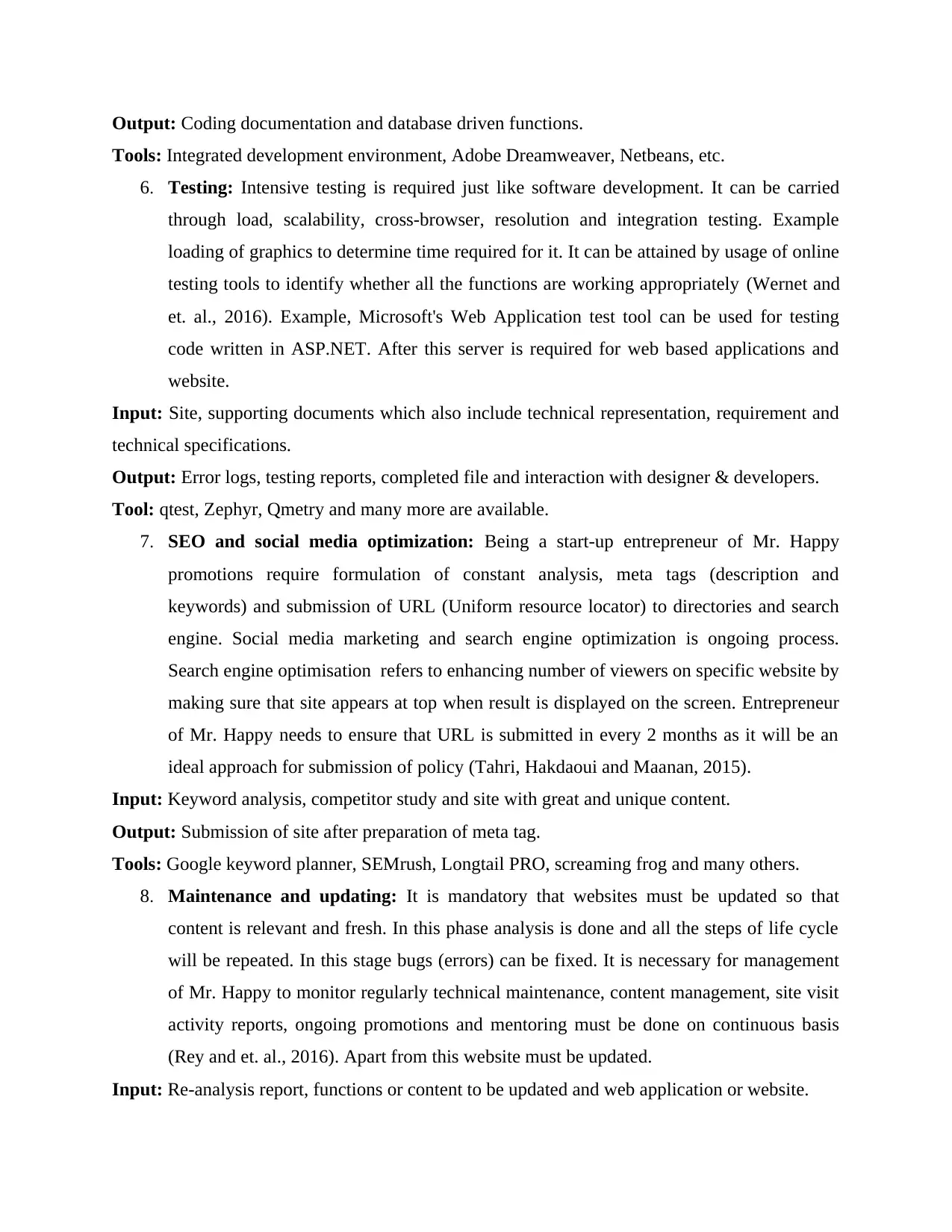
Output: Coding documentation and database driven functions.
Tools: Integrated development environment, Adobe Dreamweaver, Netbeans, etc.
6. Testing: Intensive testing is required just like software development. It can be carried
through load, scalability, cross-browser, resolution and integration testing. Example
loading of graphics to determine time required for it. It can be attained by usage of online
testing tools to identify whether all the functions are working appropriately (Wernet and
et. al., 2016). Example, Microsoft's Web Application test tool can be used for testing
code written in ASP.NET. After this server is required for web based applications and
website.
Input: Site, supporting documents which also include technical representation, requirement and
technical specifications.
Output: Error logs, testing reports, completed file and interaction with designer & developers.
Tool: qtest, Zephyr, Qmetry and many more are available.
7. SEO and social media optimization: Being a start-up entrepreneur of Mr. Happy
promotions require formulation of constant analysis, meta tags (description and
keywords) and submission of URL (Uniform resource locator) to directories and search
engine. Social media marketing and search engine optimization is ongoing process.
Search engine optimisation refers to enhancing number of viewers on specific website by
making sure that site appears at top when result is displayed on the screen. Entrepreneur
of Mr. Happy needs to ensure that URL is submitted in every 2 months as it will be an
ideal approach for submission of policy (Tahri, Hakdaoui and Maanan, 2015).
Input: Keyword analysis, competitor study and site with great and unique content.
Output: Submission of site after preparation of meta tag.
Tools: Google keyword planner, SEMrush, Longtail PRO, screaming frog and many others.
8. Maintenance and updating: It is mandatory that websites must be updated so that
content is relevant and fresh. In this phase analysis is done and all the steps of life cycle
will be repeated. In this stage bugs (errors) can be fixed. It is necessary for management
of Mr. Happy to monitor regularly technical maintenance, content management, site visit
activity reports, ongoing promotions and mentoring must be done on continuous basis
(Rey and et. al., 2016). Apart from this website must be updated.
Input: Re-analysis report, functions or content to be updated and web application or website.
Tools: Integrated development environment, Adobe Dreamweaver, Netbeans, etc.
6. Testing: Intensive testing is required just like software development. It can be carried
through load, scalability, cross-browser, resolution and integration testing. Example
loading of graphics to determine time required for it. It can be attained by usage of online
testing tools to identify whether all the functions are working appropriately (Wernet and
et. al., 2016). Example, Microsoft's Web Application test tool can be used for testing
code written in ASP.NET. After this server is required for web based applications and
website.
Input: Site, supporting documents which also include technical representation, requirement and
technical specifications.
Output: Error logs, testing reports, completed file and interaction with designer & developers.
Tool: qtest, Zephyr, Qmetry and many more are available.
7. SEO and social media optimization: Being a start-up entrepreneur of Mr. Happy
promotions require formulation of constant analysis, meta tags (description and
keywords) and submission of URL (Uniform resource locator) to directories and search
engine. Social media marketing and search engine optimization is ongoing process.
Search engine optimisation refers to enhancing number of viewers on specific website by
making sure that site appears at top when result is displayed on the screen. Entrepreneur
of Mr. Happy needs to ensure that URL is submitted in every 2 months as it will be an
ideal approach for submission of policy (Tahri, Hakdaoui and Maanan, 2015).
Input: Keyword analysis, competitor study and site with great and unique content.
Output: Submission of site after preparation of meta tag.
Tools: Google keyword planner, SEMrush, Longtail PRO, screaming frog and many others.
8. Maintenance and updating: It is mandatory that websites must be updated so that
content is relevant and fresh. In this phase analysis is done and all the steps of life cycle
will be repeated. In this stage bugs (errors) can be fixed. It is necessary for management
of Mr. Happy to monitor regularly technical maintenance, content management, site visit
activity reports, ongoing promotions and mentoring must be done on continuous basis
(Rey and et. al., 2016). Apart from this website must be updated.
Input: Re-analysis report, functions or content to be updated and web application or website.
⊘ This is a preview!⊘
Do you want full access?
Subscribe today to unlock all pages.

Trusted by 1+ million students worldwide
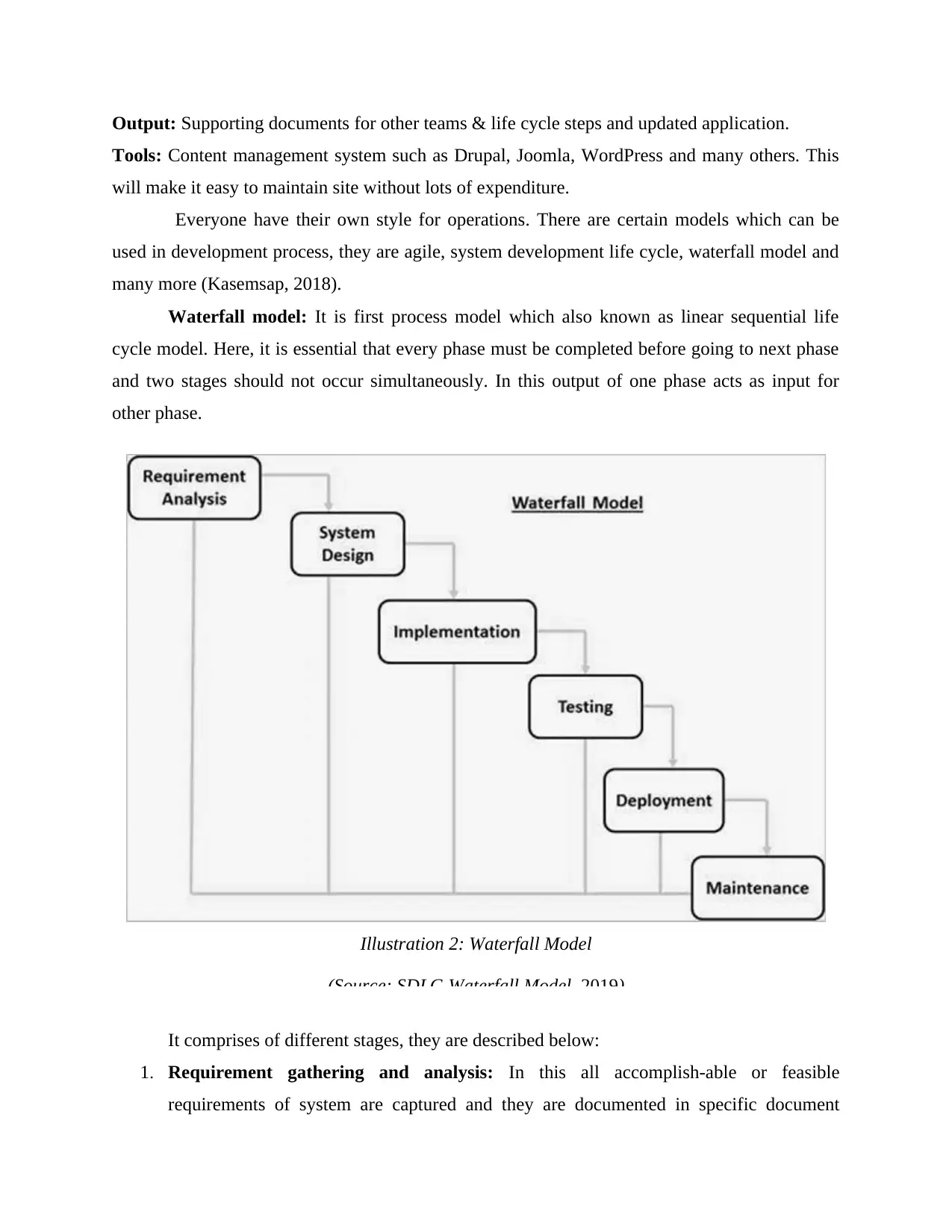
Output: Supporting documents for other teams & life cycle steps and updated application.
Tools: Content management system such as Drupal, Joomla, WordPress and many others. This
will make it easy to maintain site without lots of expenditure.
Everyone have their own style for operations. There are certain models which can be
used in development process, they are agile, system development life cycle, waterfall model and
many more (Kasemsap, 2018).
Waterfall model: It is first process model which also known as linear sequential life
cycle model. Here, it is essential that every phase must be completed before going to next phase
and two stages should not occur simultaneously. In this output of one phase acts as input for
other phase.
It comprises of different stages, they are described below:
1. Requirement gathering and analysis: In this all accomplish-able or feasible
requirements of system are captured and they are documented in specific document
Illustration 2: Waterfall Model
(Source: SDLC-Waterfall Model, 2019)
Tools: Content management system such as Drupal, Joomla, WordPress and many others. This
will make it easy to maintain site without lots of expenditure.
Everyone have their own style for operations. There are certain models which can be
used in development process, they are agile, system development life cycle, waterfall model and
many more (Kasemsap, 2018).
Waterfall model: It is first process model which also known as linear sequential life
cycle model. Here, it is essential that every phase must be completed before going to next phase
and two stages should not occur simultaneously. In this output of one phase acts as input for
other phase.
It comprises of different stages, they are described below:
1. Requirement gathering and analysis: In this all accomplish-able or feasible
requirements of system are captured and they are documented in specific document
Illustration 2: Waterfall Model
(Source: SDLC-Waterfall Model, 2019)
Paraphrase This Document
Need a fresh take? Get an instant paraphrase of this document with our AI Paraphraser
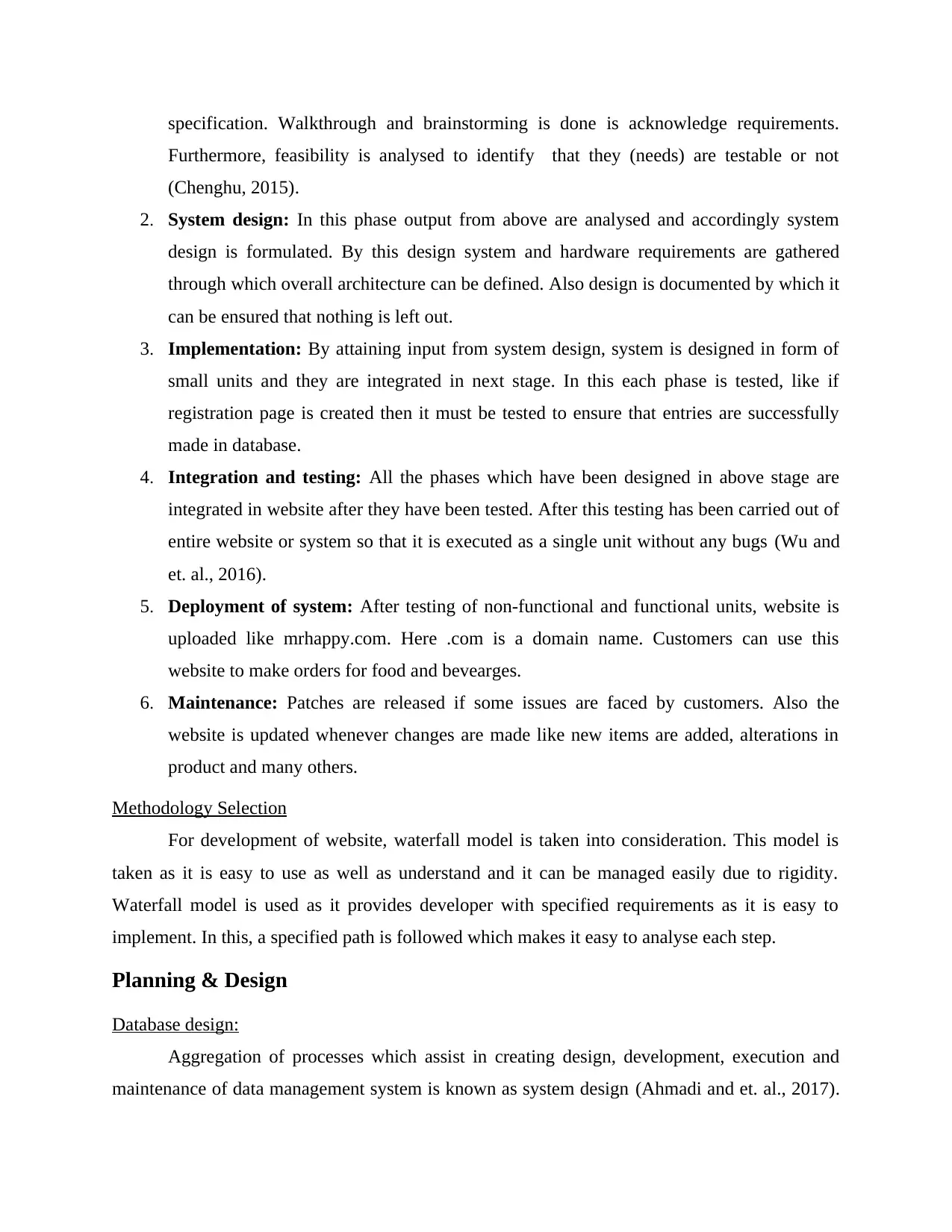
specification. Walkthrough and brainstorming is done is acknowledge requirements.
Furthermore, feasibility is analysed to identify that they (needs) are testable or not
(Chenghu, 2015).
2. System design: In this phase output from above are analysed and accordingly system
design is formulated. By this design system and hardware requirements are gathered
through which overall architecture can be defined. Also design is documented by which it
can be ensured that nothing is left out.
3. Implementation: By attaining input from system design, system is designed in form of
small units and they are integrated in next stage. In this each phase is tested, like if
registration page is created then it must be tested to ensure that entries are successfully
made in database.
4. Integration and testing: All the phases which have been designed in above stage are
integrated in website after they have been tested. After this testing has been carried out of
entire website or system so that it is executed as a single unit without any bugs (Wu and
et. al., 2016).
5. Deployment of system: After testing of non-functional and functional units, website is
uploaded like mrhappy.com. Here .com is a domain name. Customers can use this
website to make orders for food and bevearges.
6. Maintenance: Patches are released if some issues are faced by customers. Also the
website is updated whenever changes are made like new items are added, alterations in
product and many others.
Methodology Selection
For development of website, waterfall model is taken into consideration. This model is
taken as it is easy to use as well as understand and it can be managed easily due to rigidity.
Waterfall model is used as it provides developer with specified requirements as it is easy to
implement. In this, a specified path is followed which makes it easy to analyse each step.
Planning & Design
Database design:
Aggregation of processes which assist in creating design, development, execution and
maintenance of data management system is known as system design (Ahmadi and et. al., 2017).
Furthermore, feasibility is analysed to identify that they (needs) are testable or not
(Chenghu, 2015).
2. System design: In this phase output from above are analysed and accordingly system
design is formulated. By this design system and hardware requirements are gathered
through which overall architecture can be defined. Also design is documented by which it
can be ensured that nothing is left out.
3. Implementation: By attaining input from system design, system is designed in form of
small units and they are integrated in next stage. In this each phase is tested, like if
registration page is created then it must be tested to ensure that entries are successfully
made in database.
4. Integration and testing: All the phases which have been designed in above stage are
integrated in website after they have been tested. After this testing has been carried out of
entire website or system so that it is executed as a single unit without any bugs (Wu and
et. al., 2016).
5. Deployment of system: After testing of non-functional and functional units, website is
uploaded like mrhappy.com. Here .com is a domain name. Customers can use this
website to make orders for food and bevearges.
6. Maintenance: Patches are released if some issues are faced by customers. Also the
website is updated whenever changes are made like new items are added, alterations in
product and many others.
Methodology Selection
For development of website, waterfall model is taken into consideration. This model is
taken as it is easy to use as well as understand and it can be managed easily due to rigidity.
Waterfall model is used as it provides developer with specified requirements as it is easy to
implement. In this, a specified path is followed which makes it easy to analyse each step.
Planning & Design
Database design:
Aggregation of processes which assist in creating design, development, execution and
maintenance of data management system is known as system design (Ahmadi and et. al., 2017).
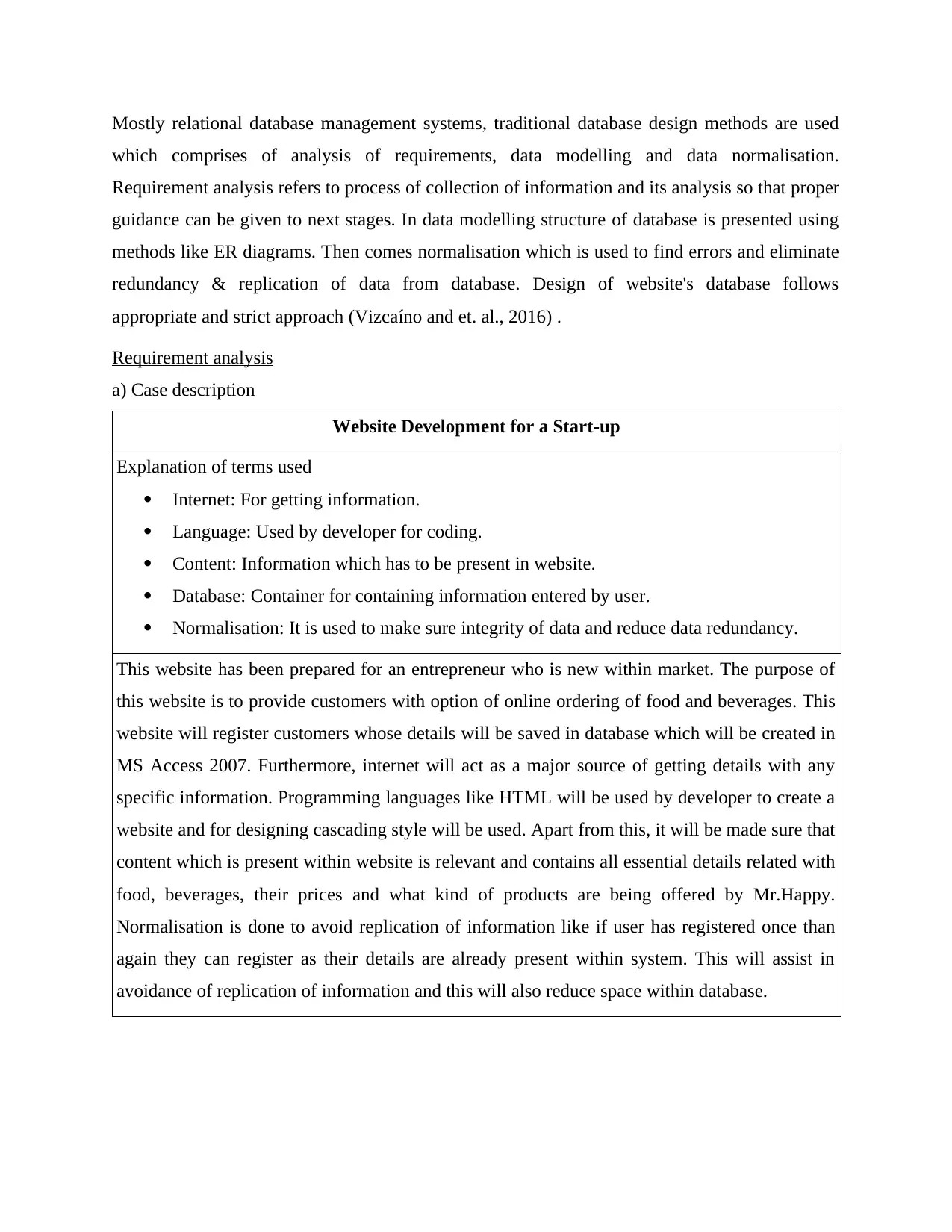
Mostly relational database management systems, traditional database design methods are used
which comprises of analysis of requirements, data modelling and data normalisation.
Requirement analysis refers to process of collection of information and its analysis so that proper
guidance can be given to next stages. In data modelling structure of database is presented using
methods like ER diagrams. Then comes normalisation which is used to find errors and eliminate
redundancy & replication of data from database. Design of website's database follows
appropriate and strict approach (Vizcaíno and et. al., 2016) .
Requirement analysis
a) Case description
Website Development for a Start-up
Explanation of terms used
Internet: For getting information.
Language: Used by developer for coding.
Content: Information which has to be present in website.
Database: Container for containing information entered by user.
Normalisation: It is used to make sure integrity of data and reduce data redundancy.
This website has been prepared for an entrepreneur who is new within market. The purpose of
this website is to provide customers with option of online ordering of food and beverages. This
website will register customers whose details will be saved in database which will be created in
MS Access 2007. Furthermore, internet will act as a major source of getting details with any
specific information. Programming languages like HTML will be used by developer to create a
website and for designing cascading style will be used. Apart from this, it will be made sure that
content which is present within website is relevant and contains all essential details related with
food, beverages, their prices and what kind of products are being offered by Mr.Happy.
Normalisation is done to avoid replication of information like if user has registered once than
again they can register as their details are already present within system. This will assist in
avoidance of replication of information and this will also reduce space within database.
which comprises of analysis of requirements, data modelling and data normalisation.
Requirement analysis refers to process of collection of information and its analysis so that proper
guidance can be given to next stages. In data modelling structure of database is presented using
methods like ER diagrams. Then comes normalisation which is used to find errors and eliminate
redundancy & replication of data from database. Design of website's database follows
appropriate and strict approach (Vizcaíno and et. al., 2016) .
Requirement analysis
a) Case description
Website Development for a Start-up
Explanation of terms used
Internet: For getting information.
Language: Used by developer for coding.
Content: Information which has to be present in website.
Database: Container for containing information entered by user.
Normalisation: It is used to make sure integrity of data and reduce data redundancy.
This website has been prepared for an entrepreneur who is new within market. The purpose of
this website is to provide customers with option of online ordering of food and beverages. This
website will register customers whose details will be saved in database which will be created in
MS Access 2007. Furthermore, internet will act as a major source of getting details with any
specific information. Programming languages like HTML will be used by developer to create a
website and for designing cascading style will be used. Apart from this, it will be made sure that
content which is present within website is relevant and contains all essential details related with
food, beverages, their prices and what kind of products are being offered by Mr.Happy.
Normalisation is done to avoid replication of information like if user has registered once than
again they can register as their details are already present within system. This will assist in
avoidance of replication of information and this will also reduce space within database.
⊘ This is a preview!⊘
Do you want full access?
Subscribe today to unlock all pages.

Trusted by 1+ million students worldwide
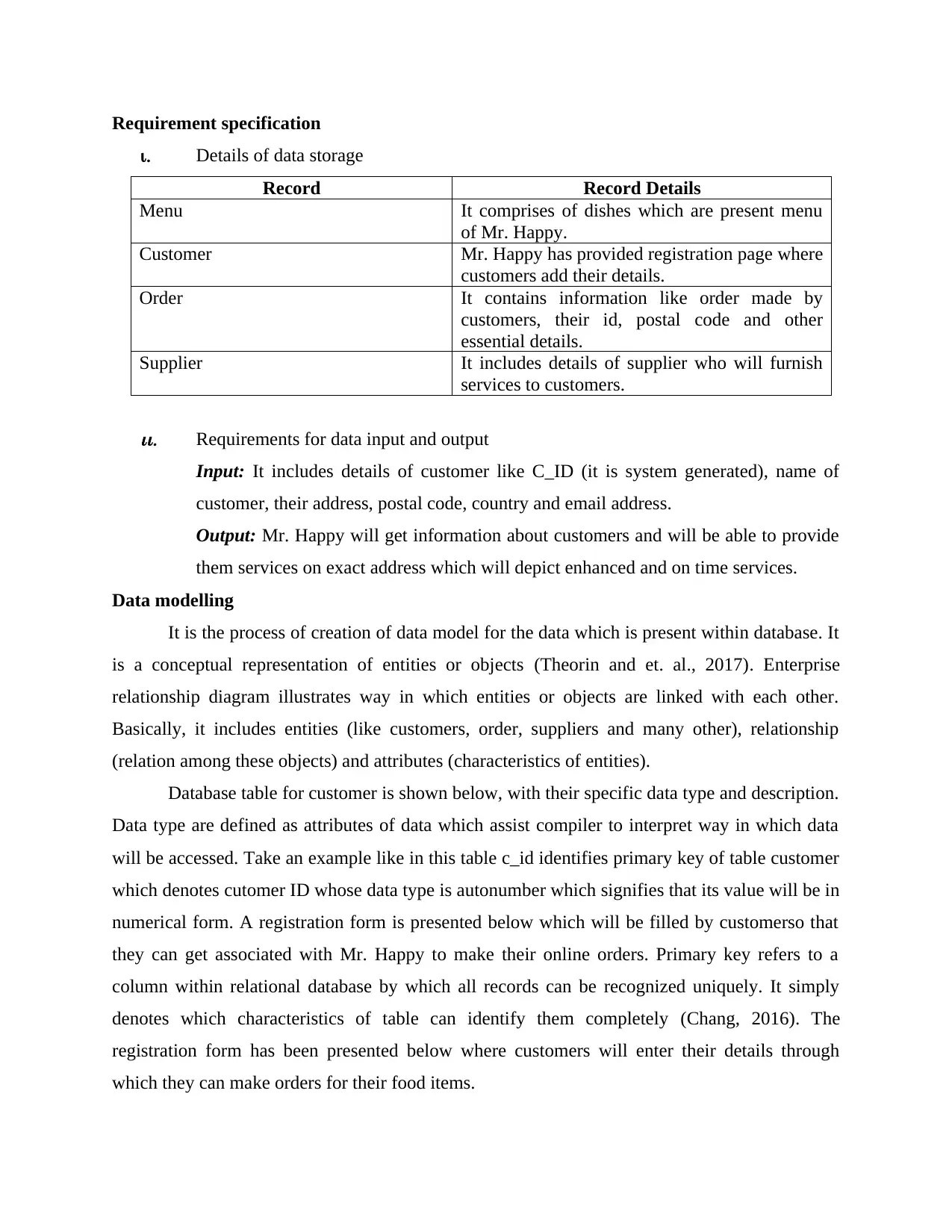
Requirement specification
i. Details of data storage
Record Record Details
Menu It comprises of dishes which are present menu
of Mr. Happy.
Customer Mr. Happy has provided registration page where
customers add their details.
Order It contains information like order made by
customers, their id, postal code and other
essential details.
Supplier It includes details of supplier who will furnish
services to customers.
ii. Requirements for data input and output
Input: It includes details of customer like C_ID (it is system generated), name of
customer, their address, postal code, country and email address.
Output: Mr. Happy will get information about customers and will be able to provide
them services on exact address which will depict enhanced and on time services.
Data modelling
It is the process of creation of data model for the data which is present within database. It
is a conceptual representation of entities or objects (Theorin and et. al., 2017). Enterprise
relationship diagram illustrates way in which entities or objects are linked with each other.
Basically, it includes entities (like customers, order, suppliers and many other), relationship
(relation among these objects) and attributes (characteristics of entities).
Database table for customer is shown below, with their specific data type and description.
Data type are defined as attributes of data which assist compiler to interpret way in which data
will be accessed. Take an example like in this table c_id identifies primary key of table customer
which denotes cutomer ID whose data type is autonumber which signifies that its value will be in
numerical form. A registration form is presented below which will be filled by customerso that
they can get associated with Mr. Happy to make their online orders. Primary key refers to a
column within relational database by which all records can be recognized uniquely. It simply
denotes which characteristics of table can identify them completely (Chang, 2016). The
registration form has been presented below where customers will enter their details through
which they can make orders for their food items.
i. Details of data storage
Record Record Details
Menu It comprises of dishes which are present menu
of Mr. Happy.
Customer Mr. Happy has provided registration page where
customers add their details.
Order It contains information like order made by
customers, their id, postal code and other
essential details.
Supplier It includes details of supplier who will furnish
services to customers.
ii. Requirements for data input and output
Input: It includes details of customer like C_ID (it is system generated), name of
customer, their address, postal code, country and email address.
Output: Mr. Happy will get information about customers and will be able to provide
them services on exact address which will depict enhanced and on time services.
Data modelling
It is the process of creation of data model for the data which is present within database. It
is a conceptual representation of entities or objects (Theorin and et. al., 2017). Enterprise
relationship diagram illustrates way in which entities or objects are linked with each other.
Basically, it includes entities (like customers, order, suppliers and many other), relationship
(relation among these objects) and attributes (characteristics of entities).
Database table for customer is shown below, with their specific data type and description.
Data type are defined as attributes of data which assist compiler to interpret way in which data
will be accessed. Take an example like in this table c_id identifies primary key of table customer
which denotes cutomer ID whose data type is autonumber which signifies that its value will be in
numerical form. A registration form is presented below which will be filled by customerso that
they can get associated with Mr. Happy to make their online orders. Primary key refers to a
column within relational database by which all records can be recognized uniquely. It simply
denotes which characteristics of table can identify them completely (Chang, 2016). The
registration form has been presented below where customers will enter their details through
which they can make orders for their food items.
Paraphrase This Document
Need a fresh take? Get an instant paraphrase of this document with our AI Paraphraser
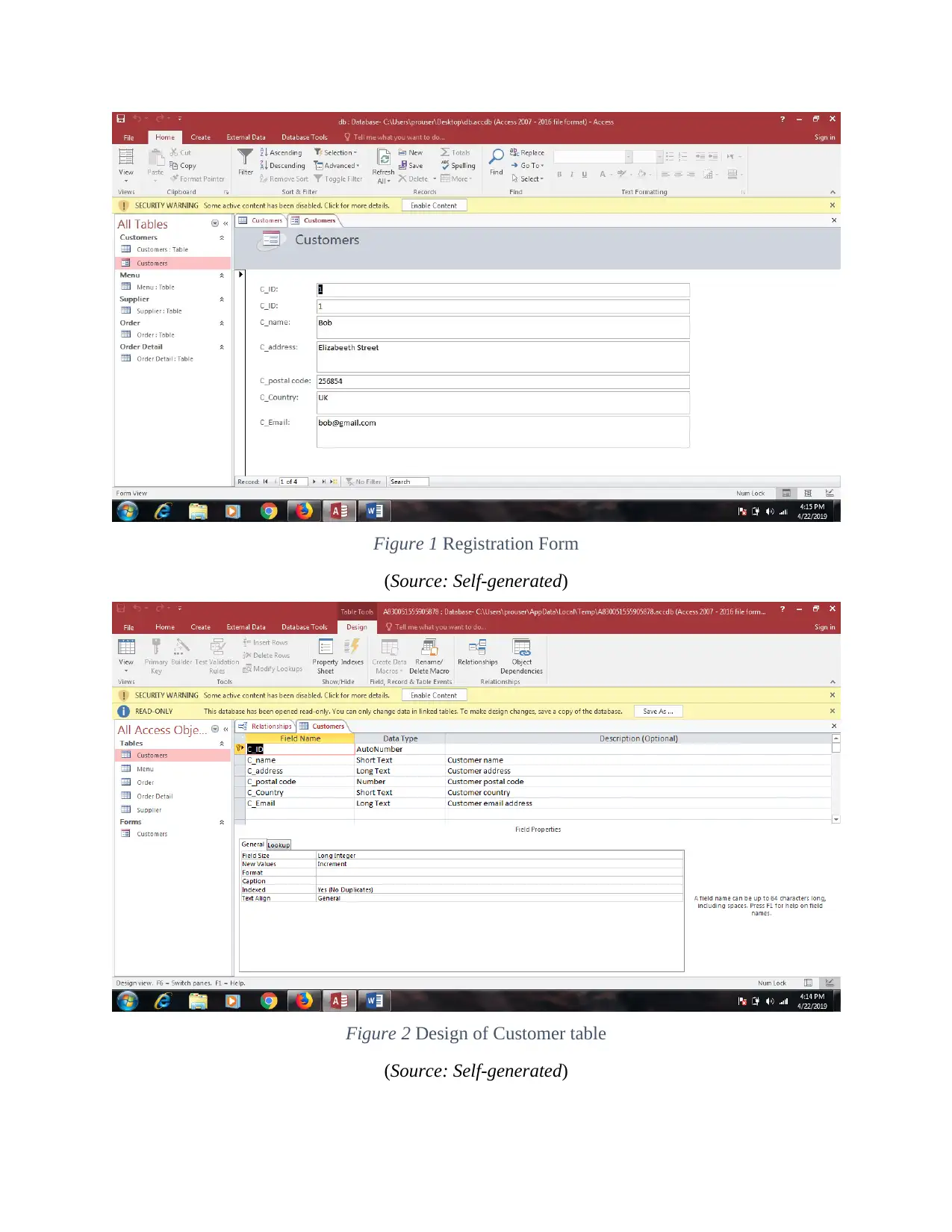
Figure 1 Registration Form
(Source: Self-generated)
Figure 2 Design of Customer table
(Source: Self-generated)
(Source: Self-generated)
Figure 2 Design of Customer table
(Source: Self-generated)
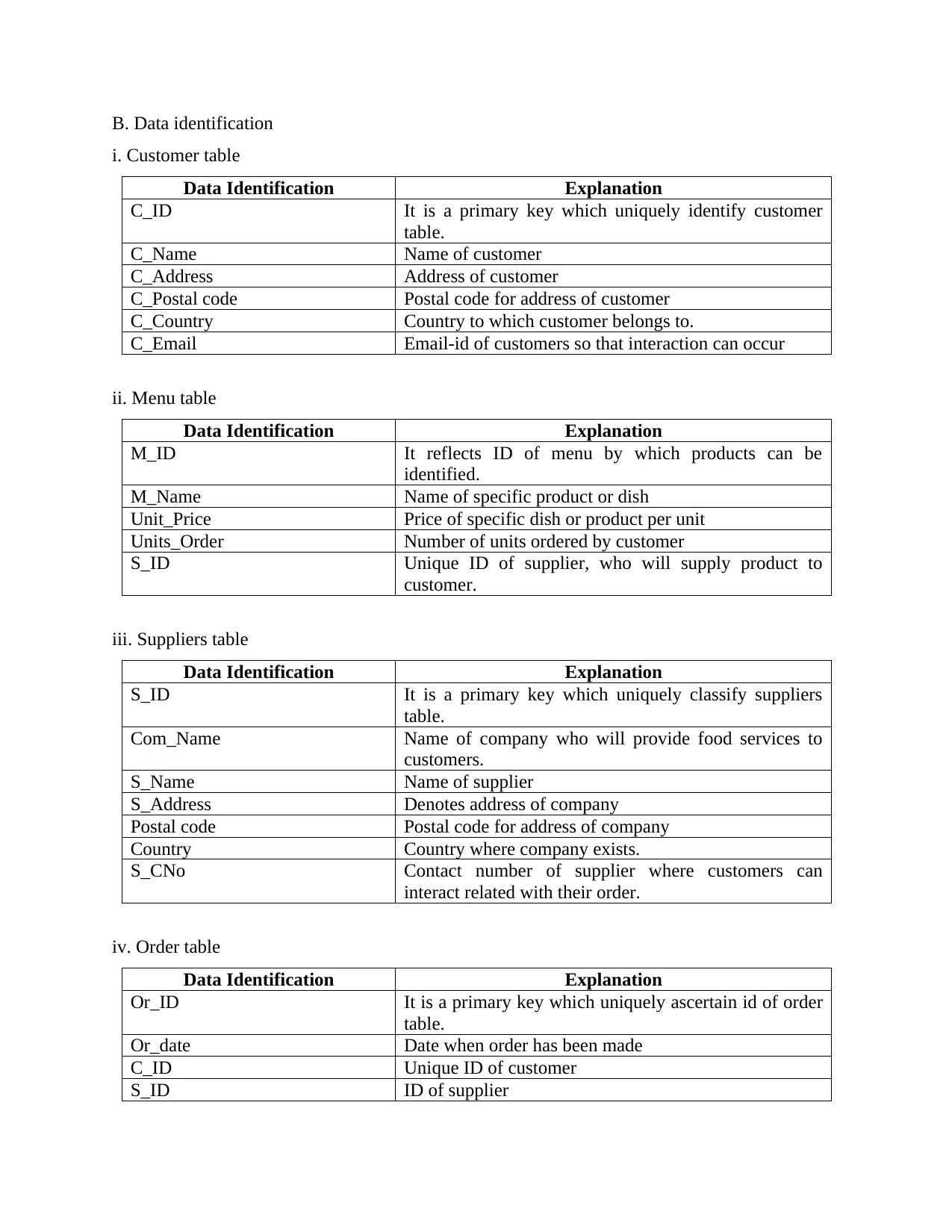
B. Data identification
i. Customer table
Data Identification Explanation
C_ID It is a primary key which uniquely identify customer
table.
C_Name Name of customer
C_Address Address of customer
C_Postal code Postal code for address of customer
C_Country Country to which customer belongs to.
C_Email Email-id of customers so that interaction can occur
ii. Menu table
Data Identification Explanation
M_ID It reflects ID of menu by which products can be
identified.
M_Name Name of specific product or dish
Unit_Price Price of specific dish or product per unit
Units_Order Number of units ordered by customer
S_ID Unique ID of supplier, who will supply product to
customer.
iii. Suppliers table
Data Identification Explanation
S_ID It is a primary key which uniquely classify suppliers
table.
Com_Name Name of company who will provide food services to
customers.
S_Name Name of supplier
S_Address Denotes address of company
Postal code Postal code for address of company
Country Country where company exists.
S_CNo Contact number of supplier where customers can
interact related with their order.
iv. Order table
Data Identification Explanation
Or_ID It is a primary key which uniquely ascertain id of order
table.
Or_date Date when order has been made
C_ID Unique ID of customer
S_ID ID of supplier
i. Customer table
Data Identification Explanation
C_ID It is a primary key which uniquely identify customer
table.
C_Name Name of customer
C_Address Address of customer
C_Postal code Postal code for address of customer
C_Country Country to which customer belongs to.
C_Email Email-id of customers so that interaction can occur
ii. Menu table
Data Identification Explanation
M_ID It reflects ID of menu by which products can be
identified.
M_Name Name of specific product or dish
Unit_Price Price of specific dish or product per unit
Units_Order Number of units ordered by customer
S_ID Unique ID of supplier, who will supply product to
customer.
iii. Suppliers table
Data Identification Explanation
S_ID It is a primary key which uniquely classify suppliers
table.
Com_Name Name of company who will provide food services to
customers.
S_Name Name of supplier
S_Address Denotes address of company
Postal code Postal code for address of company
Country Country where company exists.
S_CNo Contact number of supplier where customers can
interact related with their order.
iv. Order table
Data Identification Explanation
Or_ID It is a primary key which uniquely ascertain id of order
table.
Or_date Date when order has been made
C_ID Unique ID of customer
S_ID ID of supplier
⊘ This is a preview!⊘
Do you want full access?
Subscribe today to unlock all pages.

Trusted by 1+ million students worldwide
1 out of 20
Related Documents
Your All-in-One AI-Powered Toolkit for Academic Success.
+13062052269
info@desklib.com
Available 24*7 on WhatsApp / Email
![[object Object]](/_next/static/media/star-bottom.7253800d.svg)
Unlock your academic potential
Copyright © 2020–2025 A2Z Services. All Rights Reserved. Developed and managed by ZUCOL.





